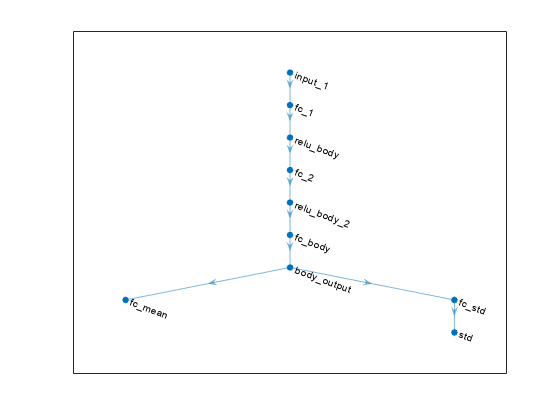getModel
Get approximation model from function approximator object
Description
Examples
Create an environment with a continuous action space and obtain its observation and action specifications. For this example, load the environment used in the example Compare DDPG Agent to LQR Controller.
Load the predefined environment.
env = rlPredefinedEnv("DoubleIntegrator-Continuous");Obtain observation and action specifications.
obsInfo = getObservationInfo(env); actInfo = getActionInfo(env);
Create a PPO agent from the environment observation and action specifications. This agent uses default deep neural networks for its actor and critic.
agent = rlPPOAgent(obsInfo,actInfo);
To modify the deep neural networks within a reinforcement learning agent, you must first extract the actor and critic function approximators.
actor = getActor(agent); critic = getCritic(agent);
Extract the deep neural networks from both the actor and critic function approximators.
actorNet = getModel(actor); criticNet = getModel(critic);
Plot the actor network.
plot(actorNet)

To validate a network, use analyzeNetwork. For example, validate the critic network.
analyzeNetwork(criticNet)
You can modify the actor and critic networks and save them back to the agent. To modify the networks, you can use the Deep Network Designer app. To open the app for each network, use the following commands.
deepNetworkDesigner(criticNet) deepNetworkDesigner(actorNet)
In Deep Network Designer, modify the networks. For example, you can add additional layers to your network. When you modify the networks, do not change the input and output layers of the networks returned by getModel. For more information on building networks, see Build Networks with Deep Network Designer.
To validate the modified network in Deep Network Designer, you must click on Analyze, under the Analysis section. To export the modified network structures to the MATLAB® workspace, generate code for creating the new networks and run this code from the command line. Do not use the exporting option in Deep Network Designer. For an example that shows how to generate and run code, see Create DQN Agent Using Deep Network Designer and Train Using Image Observations.
For this example, the code for creating the modified actor and critic networks is in the createModifiedNetworks helper script.
createModifiedNetworks
Each of the modified networks includes an additional fullyConnectedLayer and reluLayer in their main common path. Plot the modified actor network.
plot(modifiedActorNet)

After exporting the networks, insert the networks into the actor and critic function approximators.
actor = setModel(actor,modifiedActorNet); critic = setModel(critic,modifiedCriticNet);
Finally, insert the modified actor and critic function approximators into the actor and critic objects.
agent = setActor(agent,actor); agent = setCritic(agent,critic);
Input Arguments
Function approximator, specified as one of the following:
rlValueFunctionobject — Value function criticrlQValueFunctionobject — Q-value function criticrlVectorQValueFunctionobject — Multi-output Q-value function critic with a discrete action spacerlContinuousDeterministicActorobject — Deterministic policy actor with a continuous action spacerlDiscreteCategoricalActor— Stochastic policy actor with a discrete action spacerlContinuousGaussianActorobject — Stochastic policy actor with a continuous action spacerlContinuousDeterministicTransitionFunctionobject — Continuous deterministic transition function for a model-based agentrlContinuousGaussianTransitionFunctionobject — Continuous Gaussian transition function for a model-based agentrlContinuousDeterministicRewardFunctionobject — Continuous deterministic reward function for a model-based agentrlContinuousGaussianRewardFunctionobject — Continuous Gaussian reward function for a model-based agent.rlIsDoneFunctionobject — Is-done function for a model-based agent
To create an actor or critic function object, use one of the following methods.
Note
For agents with more than one critic, such as TD3 and SAC agents, you must call
getModel for each critic representation individually. You
cannot call getModel for the array returned by
getCritic.
critics = getCritic(myTD3Agent); criticNet1 = getModel(critics(1)); criticNet2 = getModel(critics(2));
Output Arguments
Version History
Introduced in R2020bUsing representation objects to create actors and critics for reinforcement learning
agents is no longer recommended. Therefore, getModel now uses function
approximator objects instead.
Starting from R2021b, built-in agents use dlnetwork objects as actor and critic representations, so getModel returns a
dlnetwork object.
Due to numerical differences in the network calculations, previously trained agents might behave differently. If this happens, you can retrain your agents.
To use Deep Learning Toolbox™ functions that do not support
dlnetwork, you must convert the network tolayerGraph. For example, to usedeepNetworkDesigner, replacedeepNetworkDesigner(network)withdeepNetworkDesigner(layerGraph(network)).
See Also
Functions
setModel|getActor|setActor|getCritic|setCritic|getNormalizer|setNormalizer|getLearnableParameters|setLearnableParameters
Objects
dlnetwork|rlValueFunction|rlQValueFunction|rlVectorQValueFunction|rlContinuousDeterministicActor|rlDiscreteCategoricalActor|rlContinuousGaussianActor|rlContinuousDeterministicTransitionFunction|rlContinuousGaussianTransitionFunction|rlContinuousDeterministicRewardFunction|rlContinuousGaussianRewardFunction|rlIsDoneFunction
MATLAB Command
You clicked a link that corresponds to this MATLAB command:
Run the command by entering it in the MATLAB Command Window. Web browsers do not support MATLAB commands.
Website auswählen
Wählen Sie eine Website aus, um übersetzte Inhalte (sofern verfügbar) sowie lokale Veranstaltungen und Angebote anzuzeigen. Auf der Grundlage Ihres Standorts empfehlen wir Ihnen die folgende Auswahl: .
Sie können auch eine Website aus der folgenden Liste auswählen:
So erhalten Sie die bestmögliche Leistung auf der Website
Wählen Sie für die bestmögliche Website-Leistung die Website für China (auf Chinesisch oder Englisch). Andere landesspezifische Websites von MathWorks sind für Besuche von Ihrem Standort aus nicht optimiert.
Amerika
- América Latina (Español)
- Canada (English)
- United States (English)
Europa
- Belgium (English)
- Denmark (English)
- Deutschland (Deutsch)
- España (Español)
- Finland (English)
- France (Français)
- Ireland (English)
- Italia (Italiano)
- Luxembourg (English)
- Netherlands (English)
- Norway (English)
- Österreich (Deutsch)
- Portugal (English)
- Sweden (English)
- Switzerland
- United Kingdom (English)